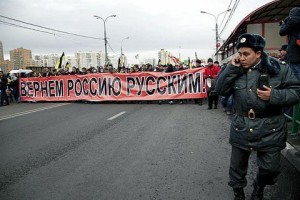Russian Holidays: День народного единства Posted by Natalie on Nov 9, 2011 in Culture, Traditions
A funny experience happened in my Russian class today, «дорогие друзья» [dear friends]. We are reading «Дама с собачкой» [The Lady with the Lapdog]. My professor said of the main character, «Гуров» [Gurov], «Он верен своей жене?» [Is he faithful to his wife?] I smiled and gave a resounding «Да, конечно» [yes, of course]. Unfortunately, that was wrong. I misread the bit where it says that «Гуров» is unfaithful to his wife: «Изменять ей он начал уже давно…» [He had started to be unfaithful to her a while ago]. And here I was thinking that meant she had perceived him to be a changed person or something like that, which admittedly did not make much sense in context. It just goes to show you: you learn something new every day!
I want to talk about a Russian holiday, «День народного единства» [Day of People’s Unity] that was recently on November 4. I am always interested to learn about foreign countries’ holidays, so I was reading about this one a little bit last week.
«День народного единства» is a recent holiday. It is observed on November 4, «начиная с 2005 (две тысячи пятого) года» [beginning with 2005] and is «нерабочий день» [a non-working day]. And even though it is recent, its history actually dates back pretty far. «27 (двадцать седьмого) октября 1612 (тысяча шестьсот двенадцатого) года гарнизон в Москве сдался» [On October 27, 1612, a garrison in Moscow was surrendered]. One year later, «земский собор избрал новым царём Михаила Романова» [the Zemsky Sobor chose Mikhail Romanov as the new tsar]. This ended the Time of Troubles and began the new Romanov dynasty.
«С 1649 (тысяча шестьсот сорок девятого) года до 1917 (тысяча девятьсот семнадцатого) года» [From 1649 to 1917] November 4 was a holiday because it marked the liberation of Moscow from the Polish-Lithuanian force.
There has been controversy about the holiday because of groups espousing «национализм и ксенофобия» [nationalism and xenophobia] demonstrating on this day, like in the photo below:
The banner says «Вернём Россию русским!» [We will return Russia to the Russians!] This is a reference to some people’s dislike of immigrants from certain regions to Russia. It is an important issue today and there are quite a few politicians in Russia who say some pretty crazy things on this matter.

Build vocabulary, practice pronunciation, and more with Transparent Language Online. Available anytime, anywhere, on any device.





Comments:
maria:
It’s one of those newly introduced holidays and most people are not aware of the history behind it. I guess that’s why it’s been high jacked by certain groups.
Richard:
A very interesting post! Thank you!
It sounds like Vladimir Putin is reaching back into Russian history in order to give a boost to national pride. Is there a parade through Red Square on Nov. 4th or is that still on Nov. 7th?
What are the politicians saying about demonstrations like the one shown? What are the people saying?
Hopefully this nationalist sentiment can be channeled into more reasonable directions and we won’t see a return of groups like “The Black Hundreds”. :-/
There’s a fine line between national pride and extreme nationalism.
Vladimir:
Richard, answering to your questions:
There are neither Nov 4 nor Nov 7 parades anymore. The only one we have left now is May 9, the Victory Day.
Politicians tend to be silent about such demonstrations.
People are confused – well, we feel that these guys are right in their ideas but definitely not their methods.
So it was petty demonstration of roughly 2000 participants. Compare to latest Muslim holiday of Kurban-Bairam when there were about 200 000 (100 times more) Muslims near Moscow Cathedral Mosque.
David:
There was a parade in Red Square on 7 Nov this year – it was the 70th anniversary of the 1941 event, when with the enemy within sight of Moscow they went ahead with the parade anyway, and the soldiers marched out of Red Square straight to the battlefront. It had a massive propaganda value, and Stalin was name by TIME magazine as “Man of the year”. Last week we played the speech Stalin made on that occasion as a listening exercise. THis link shows pictures of the event on Monday 9captions in Dutch!): http://www.nrc.nl/inbeeld/2011/11/07/russische-soldaten-marcheren-over-het-rode-plein-net-als-zeventig-jaar-geleden/
Richard:
Incredible pictures David, thanks for the link! The one with the soldier from The Great Patriotic War (Великая Отечественная Война) on his cellphone is a bit incongruous (неуместный)! LOL
I’ve read stories about how, during the defence of Moscow, workers would finish welding a tank and then the workers would get in the tank and drive it to the front to fight as the crew!
Life and fate (жизнь и судьба) for millions back then. Russians here in Canada observe May 9th, День Победы, every year.
Lest we forget!